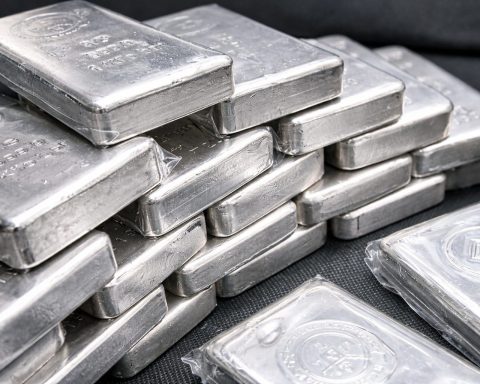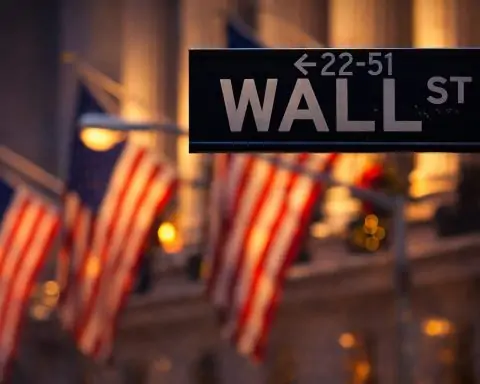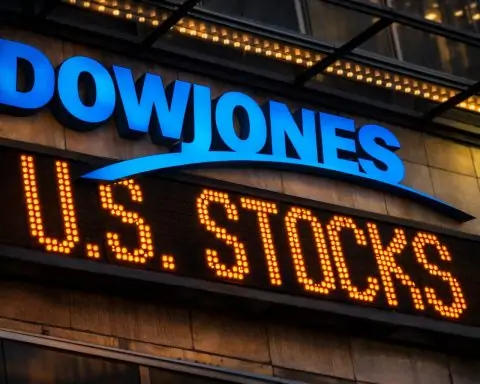- Investors braced for Powell’s Jackson Hole speech as the S&P 500 fell 0.4% and the Dow and Nasdaq were down about 0.34%.
- Cleveland Fed President Beth Hammack said there is ‘no case for reducing interest rates’ now, while Atlanta Fed President Raphael Bostic still penciled in a 2025 rate cut.
- Futures indicated a 70–75% probability of a 25-basis-point rate cut in September.
- Meta Platforms and Google announced a six-year cloud deal worth over $10 billion to expand Meta’s AI workloads on Google Cloud.
- OpenAI announced plans to open its first India office in New Delhi to tap into India’s developer talent and user base.
- Reuters sources said Nvidia’s Jensen Huang visited Taiwan’s TSMC and discussed a new AI chip for China that complies with export controls, and Nvidia asked Foxconn to pause work on its next-gen H20 chip.
- Thoma Bravo agreed to take Dayforce private for $12.3 billion, paying $70 per share, a 32% premium.
- Lowe’s will acquire Foundation Building Materials for $8.8 billion to bolster professional contractor offerings, adding FBM’s 370 locations.
- Boeing is in talks to sell up to 500 commercial jets to China in a deal potentially worth $30 billion, while about 3,200 union machinists in St. Louis have been on strike since August 1 over pay.
- China’s Country Garden won support from 77% of offshore creditors for its $14.1 billion offshore debt restructuring, even as Evergrande faces a Hong Kong delisting after an 18-month trading suspension.
Market Volatility & Central Bank Signals
Fed in Focus: Global markets seesawed as investors braced for a pivotal speech by U.S. Federal Reserve Chair Jerome Powell at Jackson Hole. On Thursday, Wall Street’s main indexes fell (S&P 500 down 0.4%, Dow and Nasdaq off 0.34%) amid fears of hawkish Fed remarks, with traders scaling back bets on a September rate cut [1] [2]. “Investors are saying, ‘You know what? Let’s take some profits right now,’” observed Sam Stovall, chief investment strategist at CFRA Research, noting jitters ahead of Powell’s comments [3]. Thin August trading volumes magnified the moves [4], and strategists warned of a selloff if Powell sounded more hawkish than expected [5]. Meanwhile, multiple Fed officials struck a cautious tone. Cleveland Fed President Beth Hammack said she “[would] not see a case for reducing interest rates” if the meeting were held now, given persistent inflation risks [6]. Atlanta Fed President Raphael Bostic still has a 2025 rate cut penciled in, but emphasized he’s “not stuck on anything” pending more data [7]. Futures are pricing around a 70–75% chance of a quarter-point cut in September [8] [9], down from near-certainty a week ago.
Global Markets Mixed: European stocks largely echoed U.S. caution – the pan-European STOXX 50 slipped ~0.2% on Thursday, though London’s FTSE 100 managed a slight gain [10]. In Asia, shares were choppy but edged higher by Friday morning. South Korea’s Kospi led with a 1% jump, and MSCI’s Asia-Pacific index hit a monthly gain of ~1.6%, as traders there also awaited Powell’s guidance [11]. Japan’s Nikkei flitted around flat, with the yen steady after data showed core inflation slightly topped forecasts, keeping pressure on the Bank of Japan [12]. Carol Kong, economist at CBA, noted “markets are on edge ahead of the all-important Jackson Hole speech,” with investors seeking clues on U.S. policy direction [13].
Central Bank Easing Abroad: In Europe, the Bank of England’s recent rate cut appears to be buoying sentiment. A survey showed UK consumer confidence hit its highest level since December, improving to -17 in August from -19, after the BoE’s surprise policy easing [14]. However, GfK’s analysts cautioned that confidence remains in a “narrow band” without a breakout of optimism yet [15]. In Germany, final data confirmed the economy contracted 0.1% in Q2, fueling speculation of further ECB stimulus. And in Asia, China’s central bank this week held its benchmark lending rates at record lows, resisting additional cuts as authorities juggle growth support with yuan stability [16].
Macro Data Bright Spots: Investors digested a mixed batch of economic data. U.S. housing showed resilience – July sales of existing homes unexpectedly ticked higher [17] even amid high mortgage rates, suggesting underlying demand. On the other hand, U.S. job market signals have softened (weekly jobless claims edged up), adding to the Fed’s dilemma. In commodities, gold prices eased as the dollar firmed and traders awaited Powell’s remarks [18]. U.S. Treasury yields fluctuated but remained elevated (10-year ~4.32%), reflecting the tug-of-war between inflation and recession fears.
Technology & Telecom: Cloud Mega-Deal and AI Moves
Meta’s $10B Cloud Alliance: A blockbuster tech partnership emerged as Meta Platforms inked a six-year cloud deal with Google worth over $10 billion [19]. Under the confidential agreement – first reported by The Information – Meta will significantly boost its use of Google Cloud’s infrastructure to support services and AI workloads [20]. The move comes after Meta CEO Mark Zuckerberg signaled plans to spend “hundreds of billions” on AI data centers, and to offload some data center assets via partnerships [21] [22]. Google and Meta declined comment, but analysts see the deal as a strategic win-win: Meta gains scalable capacity for its AI ambitions, while Google secures a marquee cloud client in the race against AWS and Microsoft. The agreement, combined with Google’s recently revealed cloud tie-up with OpenAI, underscores how even rival tech giants are collaborating amid surging demand for AI computing [23] [24].
AI Expansion and Chip News: In related news, OpenAI is expanding internationally, announcing plans to open its first India office in New Delhi as it deepens outreach in its second-largest user market [25]. The ChatGPT creator aims to tap into India’s developer talent and large user base. Meanwhile, semiconductor developments made headlines. Nvidia’s CEO Jensen Huang visited Taiwan’s TSMC and revealed he’s in talks with U.S. officials about a new AI chip for China that can comply with export curbs [26]. The GPU titan is navigating Washington’s tightening restrictions on high-end chips to China. Separately, sources say Nvidia asked partner Foxconn to pause work on its next-gen “H20” chip amid uncertain demand outlook [27]. These tidbits come as Nvidia’s earnings report looms and investors gauge whether the AI boom can sustain its stratospheric growth. Tech stocks have been volatile – after a sharp selloff earlier in the week, market leaders like Nvidia, Meta, Amazon and AMD remained slightly weaker, as some on Wall Street warn of stretched valuations and regulatory risks [28].
Enterprise Tech Deal Frenzy: The sector also saw major M&A activity. Human-resources software maker Dayforce agreed to be taken private by PE firm Thoma Bravo for $12.3 billion, marking Thoma Bravo’s largest-ever buyout [29] [30]. Dayforce (a cloud HCM platform known for AI-driven workforce analytics) will fetch $70 per share in cash, a 32% premium to its pre-rumor price [31] [32]. CEO David Ossip said going private offers “more space, flexibility and resources” to accelerate Dayforce’s focus on AI leadership in HR tech [33]. Analysts concur that Thoma Bravo’s deep pockets can relieve Dayforce’s debt load and fund aggressive AI expansion [34]. The deal continues a wave of enterprise software consolidation – just this year, Paychex bought Paycor for $4.1B and ADP acquired WorkForce Software for $1.2B, as vendors vie to build all-in-one AI-powered platforms [35]. In telecom, media talks are ongoing; for instance, French telecom giant Orange’s board met amid speculation of a tower unit sale (no official word yet). Overall, technology headlines were dominated by companies doubling down on cloud and AI strategies through partnerships and acquisitions.
Finance & Banking: Deals, Earnings and Regulatory Moves
Italian Bank Upset: In Europe’s finance sector, a high-stakes bank takeover defense fell apart. Shareholders of Italy’s Mediobanca shockingly rejected CEO Alberto Nagel’s plan to acquire wealth manager Banca Generali – a €3.5 billion proposal aimed at warding off a hostile bid from larger rival Monte dei Paschi (MPS) [36] [37]. In Thursday’s vote, only 35% of Mediobanca investors backed the Banca Generali deal, well short of the required majority [38]. Opposition was led by the bank’s two biggest investor families (Del Vecchio and Caltagirone), who saw conflicts of interest and feared dilution [39] [40]. The defeat deals a blow to Nagel’s strategy of boosting Mediobanca’s valuation – via the higher multiples of a top-tier wealth business – to make it a less attractive takeover target [41] [42]. Now, Mediobanca remains exposed as MPS (backed by the Italian state) circles. The episode underscores Italy’s banking consolidation tensions, as entrenched shareholders resist deals that threaten their influence. Mediobanca’s CEO decried “conflicts of interest” among some investors and hinted the door to MPS may now be alarmingly open [43] [44]. Bank stocks in Milan slid on the news, reflecting concerns about governance and the future of the country’s M&A reshuffle.
Wall Street & Earnings: U.S. financial firms saw relatively quieter news, but the broader market volatility kept traders busy. Analysts noted that despite near-term uncertainty, foreign investors continue snapping up U.S. assets – a trend highlighted by strong demand in recent Treasury auctions and overseas buying of equities [45] [46]. In earnings, credit card giant American Express reported solid spending trends (bolstered by travel), while a couple of regional banks hinted at stabilizing deposit outflows – modest positives for the finance sector. Also of note, the SEC approved new rules on Wednesday tightening disclosure for private fund fees and performance, a regulatory change closely watched by hedge funds and private equity. And across the pond, UBS announced it will fully absorb Credit Suisse’s domestic bank much sooner than expected, accelerating the post-takeover integration of the fallen Swiss rival (this follows UBS’s record Q2 profit from one-off accounting gains on the deal). These developments, while more incremental, show that regulatory and strategic shifts are ongoing in the banking world even as headline risks like central bank moves dominate attention.
Energy & Commodities: Oil Rebounds on War Risk
Oil’s Two-Week Rally: After weeks of decline, crude oil prices staged a rebound as geopolitical risks resurfaced. Brent crude climbed above $67.5 a barrel, on track to snap a two-week losing streak [47] [48]. The catalyst: fading optimism for an imminent Russia–Ukraine peace deal. Hopes that U.S. diplomacy might quickly broker a ceasefire have “dimmed,” raising the risk premium demanded by oil sellers [49] [50]. “It’s proving difficult to set up a Putin–Zelenskiy summit… the less likely a ceasefire looks, the more likely the risk of tougher U.S. sanctions [on Russia],” analysts at ING warned in a note [51]. Indeed, the war ground on with no let-up: Russia launched new air strikes near Ukraine’s EU border and Kyiv forces struck a Russian oil refinery in retaliation [52]. High-level talks last weekend between U.S. and Russian officials – the first since the 2022 invasion – yielded little progress toward peace [53]. With fighting unabated, traders are rebuilding a war risk premium into crude prices.
Supply & Demand Factors: Oil bulls also drew encouragement from strong U.S. demand data. The latest EIA report showed U.S. crude inventories plunging by 6 million barrels in a week – far exceeding forecasts of a 1.8M draw – signaling robust refinery activity and fuel consumption [54]. This tightening of supplies helped lift WTI crude back above $63.4 [55]. On the supply side, expectations that OPEC+ will maintain output discipline (Saudi Arabia has extended voluntary cuts into September) are providing a floor under prices. Additionally, a major hurricane developing in the Gulf of Mexico raised slight concerns about U.S. offshore production disruptions. Overall, Brent is up ~2.7% for the week and WTI +1.1%, set for their first weekly gains this month [56]. Energy stocks rallied accordingly, and some analysts predict oil could grind higher into autumn if central banks begin easing – lower interest rates tend to stimulate economic growth and oil demand [57]. However, any breakthrough in Ukraine peace talks or revival of Iranian oil exports could cap the upside. Natural gas markets were relatively calm by comparison, with U.S. Henry Hub prices around $2.70/mmbtu as ample summer inventories counterbalanced heatwave-driven power demand.
Metals & Others: In metals, gold hovered near $1,900/oz, inching down as the dollar strengthened [58]. Base metals were mixed – copper steadied around $8,770/tonne amid optimism about Chinese stimulus measures, while iron ore ticked up on reports that China may ease property restrictions to spur steel demand. Agricultural commodities saw volatile trading after Russia warned that ships heading to Ukraine’s Black Sea ports could be considered hostile (worrying grain traders), yet global wheat prices eased on hopes that alternate export routes via the EU are expanding.
Industry & Manufacturing: Aerospace Deals and Strikes
Boeing’s China Breakthrough: In a potential game-changer for aviation, Boeing is reportedly in talks to sell as many as 500 commercial jets to China [59] [60]. Bloomberg first reported (and Reuters confirmed via sources) that the U.S. planemaker is negotiating a massive order – potentially worth $30+ billion – as part of a U.S.–China trade pact [61] [62]. The deal, if finalized, would mark China’s first major purchase of Boeing aircraft in years, after a long freeze amid trade tensions. Shares of Boeing jumped ~2% on the news [63] [64]. The two sides are discussing jet models, quantities and delivery schedules, with insiders suggesting such an order could be the centrepiece of a broader trade agreement between Washington and Beijing [65]. Boeing declined to comment on “speculation” [66], but analysts note this could dramatically narrow Airbus’s lead in China [67]. European rival Airbus has outsold Boeing in China recently, partly due to geopolitics, so a blockbuster sale would be a coup for Boeing and the U.S. administration. Chinese officials have even begun consulting airlines about their Boeing jet requirements, signaling seriousness [68]. Any deal would also highlight the geopolitical stakes: jet purchases have become fixtures of high-level diplomacy – during a Middle East visit earlier this year, President Trump helped Boeing clinch $96B in orders from Qatar Airways [69]. Industry experts say a China order of this magnitude, if it materializes, would boost Boeing’s production plans and could add 5-10% to its multiyear revenue outlook.
Labor Unrest Hits Defense Units: Even as its commercial division anticipates new orders, Boeing’s defense business is grappling with a strike. About 3,200 union machinists in the St. Louis area have been on strike since August 1, shutting down production of F-15 and F/A-18 fighter jets [70] [71]. This week, the standoff continued with no resolution in sight. Striking workers – represented by the IAM – are holding out for pay raises closer to 38% over the contract term, significantly above Boeing’s last offer [72] [73]. Boeing’s local executive Dan Gillian defended the company’s rejected offer as “strong,” but union officials (joined at the picket line by a U.S. congressman) urged Boeing to match the pattern of recent generous deals won by its Seattle-area workers [74]. The halt in production has delayed deliveries of the latest F-15EX fighters and final F/A-18 Super Hornets. Defense analysts warn that if the impasse drags on, Boeing could face penalty costs from its military customers and a hit to Q3 defense revenues. The strike highlights surging wage pressures in manufacturing as workers leverage a tight labor market and high inflation – a trend also seen at U.S. automakers (where the UAW is in tough talks ahead of a contract deadline next month).
Industrial Shake-ups: In the materials industry, International Paper announced a sweeping restructuring. The Memphis-based packaging giant will sell its Global Cellulose Fibers division for $1.5 billion to private equity firm American Industrial Partners [75], refocusing on core packaging segments. The unit, which makes pulp for diapers, tissues and other products, had $2.8B in 2024 revenue and 3,300 employees [76]. Alongside the divestiture, International Paper is investing $250M to convert an Alabama mill to containerboard and will close two Georgia mills and a box plant, eliminating around 1,100 jobs [77] [78]. The cost-cutting move is aimed at streamlining operations amid rising input costs and shifting demand. CEO Andy Silvernail said the buyer AIP is “focused on investing in and growing industrial businesses,” expressing confidence that the spun-off fibers unit will thrive under new ownership [79]. The deal continues a trend of conglomerates shedding non-core divisions to boost efficiency. Investors cheered IP’s plans, sending the stock up 3% on hopes of margin improvement. Elsewhere in manufacturing, Eurozone factory PMIs (purchasing indexes) for August hinted at continued contraction, but at a slowing pace, suggesting the worst of Europe’s manufacturing downturn may be passing. And in autos, Japanese officials reportedly are considering relief measures for car exporters as the yen’s weakness (near ¥148/$) heightens import costs – Japan’s government has grown vocal about possibly raising its assumed bond yield in budgets to reflect market rates [80], a sign of changing financial conditions that could affect industrial borrowing.
Retail & Consumer: Mixed Earnings and Big Retailer Moves
Walmart’s Rare Miss: The world’s largest retailer Walmart delivered a mixed message that rattled consumer stocks. While Walmart’s sales proved resilient, it missed quarterly profit expectations for the first time in several years, citing higher costs from tariffs and shrink [81] [82]. The company actually raised its full-year sales and earnings outlook, thanks to “strong demand from shoppers across all income levels,” but margins were squeezed in the latest quarter [83] [84]. Walmart also flagged rising expenses related to import tariffs (part of the ongoing U.S.–China trade saga) cutting into profit [85] [86]. Investors punished the stock, which tumbled about 4.5% on Thursday [87]. That drag helped pull the entire consumer staples sector down over 1% [88]. The earnings stumble from a normally dependable bellwether spooked the market, especially coming a day after rival Target had posted solid results. “There’s a bit of a mixed picture within the consumer space and… uncertainty in the economy,” noted Chris Zaccarelli of Northlight Asset Management, citing tariff-driven price pressures and an uneven post-pandemic spending landscape [89]. Nonetheless, Walmart’s management remains optimistic about back-half trends, pointing to strong grocery and online sales, and they announced plans to moderate price increases to stay competitive.
Other Retail Highlights: It’s been a busy week for retail earnings overall. Target beat expectations on earnings earlier in the week, but its cautious guidance (amid theft and consumer spending shifts) kept gains in check. Home Depot likewise reported better-than-feared sales and maintained its outlook, reassuring investors after a spring slump in home improvement demand. Notably, Lowe’s – Home Depot’s chief competitor – not only topped its earnings forecast but unveiled a major acquisition: it will buy Foundation Building Materials (FBM) for $8.8 billion to bolster its offerings to professional contractors [90] [91]. FBM is a leading distributor of drywall, ceiling panels and insulation with 370 locations in North America [92]. Lowe’s CEO Marvin Ellison said the deal (Lowe’s second pro-focused buy this year) will “enhance our Pro penetration” and position the company for long-term sales growth [93] [94]. The acquisition, announced alongside a raised full-year outlook from Lowe’s, was cheered by investors; Lowe’s stock jumped and even outperformed Home Depot, which itself had acquired a smaller building products firm in June. This signals a consolidation trend in the home improvement supply chain, as retailers seek to capture the booming trade customer segment.
In luxury retail, French conglomerate LVMH hinted at a slowdown in U.S. high-end demand but continued robust growth in Asia, echoing what Tapestry and Estée Lauder said earlier this month. Coty Inc., the beauty products maker, saw its shares plunge 21% after it forecast weaker sales for the current quarter due to a pullback in U.S. consumer spending on cosmetics [95]. That warning dragged down other cosmetics stocks and shows that even the beauty boom is moderating. On the brighter side, e-commerce remains strong – Amazon reported record sales during its August “Prime Day 2” event, and Alibaba’s international arm saw double-digit growth, indicating online retail is holding up globally. Consumer sentiment metrics are mixed: the U.S. Michigan survey ticked down slightly (with inflation expectations stable), while UK consumers, as noted, grew a tad more confident post-rate cuts. Overall, the retail sector is sending conflicting signals – value-focused giants like Walmart feeling margin pain, even as higher-end spending and housing-related retail show pockets of strength.
Real Estate & Housing: Housing Data Up, China’s Property Woes
Housing Resilience in the West: The U.S. housing market offered a surprise upside in data this week. Despite 30-year mortgage rates hovering around 6.6% (the highest in years), July existing home sales rose about 2%, defying expectations of a decline [96]. Tight inventory and solid job markets appear to be sustaining homebuying for now. Realtors noted that while high rates are a headwind, motivated buyers are finding creative financing and sellers are offering more concessions. Home prices nationally are roughly flat year-on-year, and builders’ sentiment has improved, suggesting new construction is picking up to meet demand. Meanwhile, UK home prices are facing a cooler patch; anecdotal reports point to price cuts on luxury London listings after the Bank of England’s earlier tightening (though the BoE’s recent rate cut may soon ease mortgage costs). Across Europe, housing markets are mixed: German Q2 GDP at -0.1% reflects part of the strain from a construction slump in Europe’s largest economy. Yet, low unemployment and wage growth have so far prevented a sharp housing crash. In some Asia-Pacific markets like Australia and New Zealand, central banks pausing rate hikes have led to a slight rebound in home sales this month.
China’s Property Crisis Deepens: The most troubling real estate news continues to emanate from China’s beleaguered property sector. This week, Country Garden, once China’s top developer, announced it secured support from a key group of bank creditors for its $14.1 billion offshore debt restructuring plan [97] [98]. Holders of 77% of the debt’s value have agreed to the overhaul, crossing the threshold needed to move forward [99] [100]. This is a rare positive step as Country Garden fights to avoid default after it stopped repaying $11B in offshore bonds late last year [101] [102]. However, the company remains under a liquidation petition with a court hearing in January, and still must convince remaining creditors by year-end [103]. The broader outlook is grim: China Evergrande Group, the poster child of the crisis, is on the brink of an unprecedented delisting from the Hong Kong stock exchange after failing to execute a viable debt restructuring [104] [105]. Evergrande’s 18-month trading suspension will culminate in delisting by next week, a symbolic blow that “adds to the gloom hanging over other developers” scrambling to stay afloat [106] [107]. The Chinese property market has been in a multi-year tailspin – new home prices are falling at the fastest pace in 8 months [108], and over 70% of Chinese developers’ dollar bonds have defaulted since 2021 [109] [110]. “There’s no light at the end of the tunnel,” remarked Deloitte’s restructuring head Glen Ho, noting that even completed debt revamps are failing to restore confidence amid sliding demand [111] [112]. The government has rolled out piecemeal support (lower mortgage rates for first-time buyers, targeted credit easing), but so far that’s not turned the tide. Real estate, which comprises up to 30% of China’s GDP including related industries, remains a major drag on its economy and a risk for global commodity markets. International investors are cautiously watching if Beijing will step up with more forceful stimulus or bailout measures to prevent a wider financial contagion from the property meltdown.
Sources: Reuters, Bloomberg, company press releases, official statements. Key references include Reuters market reports [113] [114], central bank commentary [115] [116], corporate news from Reuters [117] [118], and industry analysis [119] [120], among others, as cited above.
References
1. www.reuters.com, 2. www.reuters.com, 3. www.reuters.com, 4. www.reuters.com, 5. www.reuters.com, 6. www.reuters.com, 7. www.reuters.com, 8. www.reuters.com, 9. www.reuters.com, 10. www.reuters.com, 11. www.reuters.com, 12. www.reuters.com, 13. www.reuters.com, 14. www.reuters.com, 15. www.reuters.com, 16. tradingeconomics.com, 17. www.reuters.com, 18. www.reuters.com, 19. www.reuters.com, 20. www.reuters.com, 21. www.reuters.com, 22. www.reuters.com, 23. www.reuters.com, 24. www.reuters.com, 25. www.reuters.com, 26. www.reuters.com, 27. www.reuters.com, 28. www.reuters.com, 29. www.reuters.com, 30. www.reuters.com, 31. www.reuters.com, 32. www.reuters.com, 33. www.reuters.com, 34. www.reuters.com, 35. www.reuters.com, 36. www.reuters.com, 37. www.reuters.com, 38. www.reuters.com, 39. www.reuters.com, 40. www.reuters.com, 41. www.reuters.com, 42. www.reuters.com, 43. www.reuters.com, 44. www.reuters.com, 45. www.reuters.com, 46. www.reuters.com, 47. www.reuters.com, 48. www.reuters.com, 49. www.reuters.com, 50. www.reuters.com, 51. www.reuters.com, 52. www.reuters.com, 53. www.reuters.com, 54. www.reuters.com, 55. www.reuters.com, 56. www.reuters.com, 57. www.reuters.com, 58. www.reuters.com, 59. www.reuters.com, 60. www.reuters.com, 61. www.reuters.com, 62. www.reuters.com, 63. www.reuters.com, 64. www.reuters.com, 65. www.reuters.com, 66. www.reuters.com, 67. www.reuters.com, 68. www.reuters.com, 69. www.reuters.com, 70. www.reuters.com, 71. www.reuters.com, 72. www.reuters.com, 73. www.reuters.com, 74. www.reuters.com, 75. internationalpaper2022rd.q4web.com, 76. internationalpaper2022rd.q4web.com, 77. internationalpaper2022rd.q4web.com, 78. internationalpaper2022rd.q4web.com, 79. internationalpaper2022rd.q4web.com, 80. www.reuters.com, 81. www.reuters.com, 82. www.reuters.com, 83. www.reuters.com, 84. www.reuters.com, 85. www.reuters.com, 86. www.reuters.com, 87. www.reuters.com, 88. www.reuters.com, 89. www.reuters.com, 90. www.alphaspread.com, 91. www.alphaspread.com, 92. www.alphaspread.com, 93. www.alphaspread.com, 94. www.alphaspread.com, 95. www.reuters.com, 96. www.reuters.com, 97. www.reuters.com, 98. www.reuters.com, 99. www.reuters.com, 100. www.reuters.com, 101. www.reuters.com, 102. www.reuters.com, 103. www.reuters.com, 104. www.reuters.com, 105. www.reuters.com, 106. www.reuters.com, 107. www.reuters.com, 108. www.reuters.com, 109. www.reuters.com, 110. www.reuters.com, 111. www.reuters.com, 112. www.reuters.com, 113. www.reuters.com, 114. www.reuters.com, 115. www.reuters.com, 116. www.reuters.com, 117. www.reuters.com, 118. www.reuters.com, 119. www.reuters.com, 120. www.reuters.com










